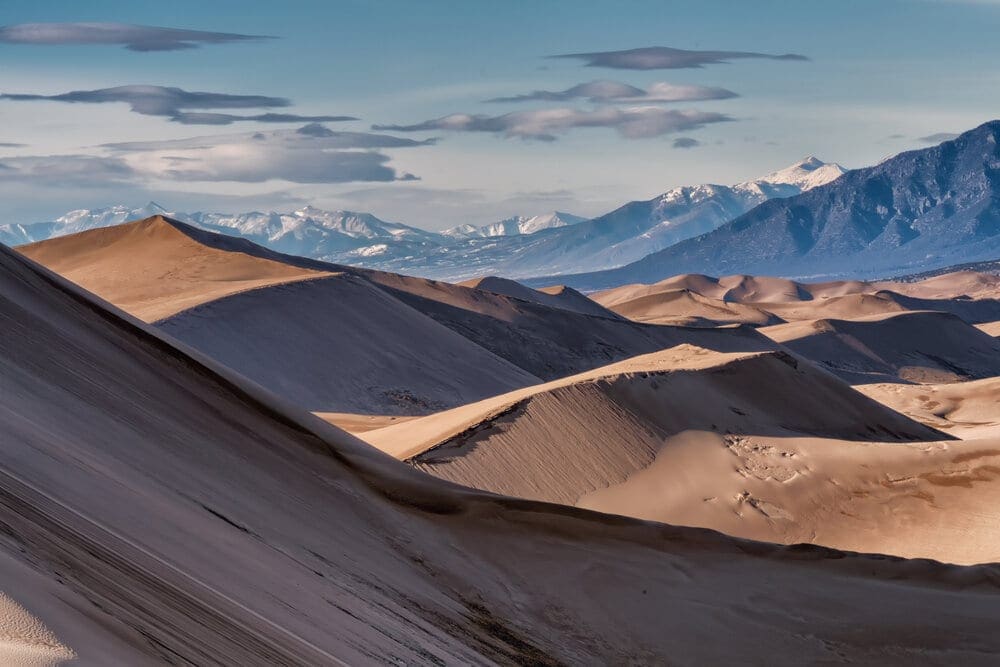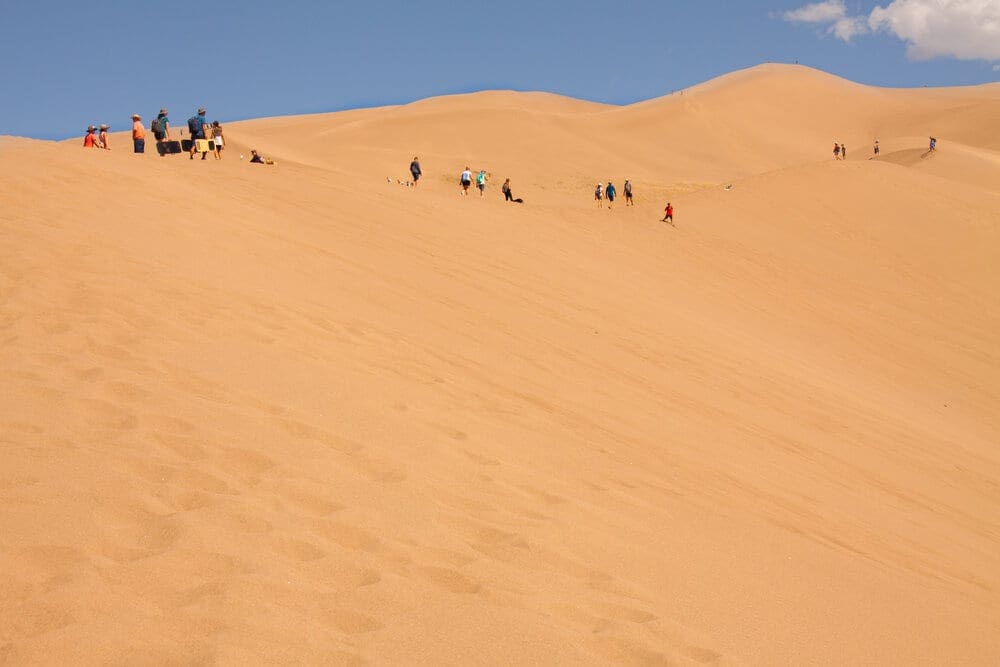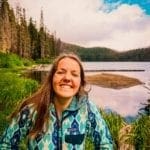|
Getting your Trinity Audio player ready...
|
Established in 2004
Tucked away in the heart of Colorado, lies a hidden gem that will take your breath away. The Great Sand Dunes, with their towering mountainous backdrop, are like a mystical oasis plucked straight from the Sahara Desert. A place where adventure awaits at every turn and Mother Nature’s wonders reign supreme.
Perched on the edge of the San Luis Valley in Colorado lies the Great Sand Dunes National Park and Preserve. This 149,000 acre protected swath of land boasts the tallest sand dunes in America, reaching up to 750 feet.
These ever-shifting dunes have been shaped by time, revealing a diverse landscape that beckons adventure-seekers. The winding Medano Creek divides the towering dunes from the rugged peaks of the Sangre de Cristo Mountains, creating a striking contrast.
Amongst this high desert terrain, an abundance of wildlife thrives, making it a paradise for avid explorers and outdoor enthusiasts. Prepare to be awestruck by some of the most stunning views that Colorado has to offer in this adrenaline-fueled playground.
Getting to Great Sand Dunes National Park:
Located in southern Colorado, Great Sand Dunes National Park is an extraordinary place to visit. Situated approximately 234 miles from Denver and 246 miles from Albuquerque, it offers a variety of travel options for visitors.
From Denver: The standard route involves taking I-25 South to Walsenburg, then heading West on US 160 and North on State Highway 150. Or, for a more picturesque journey from Denver (with the same distance as the I-25 route), one can take US 285 South, followed by State Highway 17 South and finally County Lane 6 East from Mosca.
From Albuquerque: Head in a northerly direction on I-25 until you reach Santa Fe, then continue north on US 285 until you reach Alamosa. From there, you have two options: (1) Take the eastbound US Highway 160 and head north on State Highway 150. (2) Alternatively, venture north on State Highway 17 and make your way east on County Lane 6 from Mosca.
Driving Mileages to Great Sand Dunes Visitor Center:
- Alamosa: 37 miles
- Albuquerque: 246 miles
- Denver via US 285: 234 miles
- Colorado Springs via I-25 and Walsenburg: 167 miles
- Santa Fe: 184 miles
Keep in mind that the nearest gas stations open 24/7 are located in Mosca, a 23-mile drive west of the park Visitor Center, and Fort Garland, about 31 miles to the southeast. Also, be cautious when relying solely on computer mapping programs for highway travel in the Rocky Mountains, as they may provide inaccurate directions.
History:
The first evidence of humans within the region dates back over 11,000 years. Hunter and gatherers lived within the land, amongst the bison and mammoths that once roamed. While Native American tribes did not predominantly live in the dunes, local tribes were familiar with the land. These surrounding tribes were familiar with the unique landscape and have terms for it that translate to “sand that moves”, “it goes up and down”, and “White Shell Mountain”. For many years the tribes used resources from the land on occasion. The Pueblos hold great significance to one of the lakes that lies just west of the dunes.
It wasn’t until the late 1600’s that a known European began exploring the dunes. It was during this time that large hunting expeditions were led out of the Santa Fe region. This continued for over 100 years with the first written description of the dunes occurring in 1807 as the Lewis and Clark expedition was returning east across the country. In the 1870s the Mosca Pass Toll Road was established after many wagon routes and rough roads had made their way around the dunes and out to the western United States.
While the gold rush was flourishing, local communities feared that the sand dunes would be subjective to being overrun. Thus, in the 1920’s local communities backed a bill put out by the P.E.O. Sisterhood that worked to mark the region as a national monument. In 1932, President Hoover signed the bill into law. The monument became a national park in the 1990s and expanded into the park and preserved we now have in 2004.
Geology:
The Great Sand Dunes are home to the tallest sand dunes in all of North America. They lie within the San Luis Valley of Colorado, with the tallest peaks standing at 750 feet above the valley floor. While the dunes have grown and shifted over time, today they cover an area that is approximately 30 square miles. The formation of these dunes is largely based off of the San Luis Valley.
The valley was formed when the Sangre de Cristo Range was raised upward by a tectonic plate. To the west of the valley lies the San Juan Mountains. Unlike the Sangre de Cristo Range, the San Juan Mountains were formed by excessive volcanic activity. Overtime, debris and rocks from these ranges were carried down into the San Luis Valley. As glaciers melted, vast amounts of water filled the valley creating a massive lake.
But Lake Alamosa eventually drained through what is now the Rio Grande. Over time the smaller lakes that were left behind, dried up due to natural occurrences of climate change. The sand that was left behind was moved by the southwest winds, pushing the dune. Naturally opposing winds have caused these dunes to grow vertically over time, reaching the heights that they are today. A majority of the main dunes, stays relatively put, with small shifts of the sand. However, smaller dunes continue to migrate across the valley floor, often stopping once they reach the main dunes or if vegetation begins to grow on them.
While the dunes attract the crowds, the Great Sand Dunes National Park and Preserve also encompasses part of the Sangre de Cristo Range which is part of the much larger Rocky Mountains. Elevations within the park range from 7,515 feet up to 13,604 feet. The highest point in the park and preserve is Tijeras Peak. Medano Creek runs north to south, separating the dunes from the rugged and snow capped mountain range.
Because the park and preserve are located in high desert elevations, the summer temperatures are moderate, often in the mid 80s while winter temperatures frequently drop below freezing. The generally moderate temperatures allow the dunes to be accessed for most of the year.

The Great Sand Dunes are home to the tallest sand dunes in all of North America.
Flora and Fauna:
While the sandy dunes take up much of the landscape, the park is still home to hundreds of plant and animal species. Along the foothills of the mountains lie aspen, Douglas fir, ponderosa pine, Rocky Mountain juniper, and various other species of trees. Flowering plants, shrubs, and grasses comprise the lower landscapes, including forget-me-not, dwarf clover, primrose, as well as inland saltgrass.
Between the wetlands, expansive dunes, and rugged Rocky Mountains, the park is home to a variety of wildlife. Major species include marmot, black bear, cougar, coyote, mule deer, porcupine, bighorn sheep, elk, and a population of bison who are protected by The Nature Conservancy. Besides mammals, the region is home to hundreds of bird species, reptiles, fish, and amphibians. The Great Sand Dunes have numerous endemic species, most of which are beetles.

Back in 2019, the park was designated a Dark Sky Park. This means that artificial light pollution is restricted to help ensure the keep the sky dark, and help promote astronomy and stargazing.
Main Attractions:
True to its name, one of the most popular features of the park is the main dune field. Here tourists can explore the massive dunes, by easy trails or climbing to the tallest peak. As impressive as the wetlands and Rocky Mountains are, Medano Creek is also a unique feature of the park. The unique location of the creek, on the east side of the dunes, means that the water doesn’t have a designated steam bed. As the sand shifts and falls across the creek, it must break through or find the path of least resistance.
While the day time is sure to bring many sights and adventures to those who visit, the Great Sand Dunes National Park and Preserve is also a popular destination once the sun sets. Back in 2019, the park was designated a Dark Sky Park. This means that artificial light pollution is restricted to help ensure the keep the sky dark, and help promote astronomy and stargazing.
Hiking:
One of the most popular activities in the park is hiking. Because of the diverse range of ecosystems, the Great Sand Dunes National Park offers seemingly endless terrain to explore. Hiking is permitted throughout the Great Dunes, though it is noted that in the summer months the sand can reach temperatures of up to 150 degrees Fahrenheit.
Great Sand Dunes National Park in Colorado offers a variety of hiking trails for all skill levels. Here are some of the best hiking trails in the park:
- High Dune: This 3-mile round-trip hike takes you to the top of the tallest sand dune in the park, offering stunning views of the surrounding dunes and the Sangre de Cristo Mountains.
- Star Dune: A challenging 8-mile round-trip hike, Star Dune is the tallest dune in North America, standing at 750 feet. The hike provides breathtaking views of the entire dune field.
- Mosca Pass Trail: A moderate 7-mile round-trip hike, this trail takes you through a forested area and offers a different perspective of the park, with views of the dunes and the Sangre de Cristo Mountains.
- Sand Ramp Trail: This 6.7-mile round-trip hike takes you through the grasslands and wetlands at the base of the dunes, offering a unique perspective of the park’s diverse ecosystem.
- Montville Nature Trail: A short and easy 0.5-mile loop, this trail offers a gentle introduction to the park, with interpretive signs providing information about the area’s history and geology.
Remember to bring plenty of water, wear sunscreen, and wear appropriate footwear for hiking on sand. Enjoy your adventure in Great Sand Dunes National Park!

Tourist hikers walk on giant desert sand dunes at the Great Sand Dunes National Park and Preserve.
Sandboarding and Sand Sledding:
The unique dunes of the park make it perfect for sandboarding and sand sledding. After hiking up the tallest dunes in the park, tourists can take the scenic way back down along a sand board. Traditional skis, snowboards, or even snow sleds won’t work for cruising down the dunes. There are numerous places to rent boards and sleds in the nearby towns, allowing for endless fun amongst the 30 square miles of dunes.

Woman with sand board walking on edge of a sand dune in the Great Sand Dunes National Park and Preserve, Colorado.
4WD Medano Pass Road:
Across the Great Sand Dunes National Park and Preserve lies the 22-mile road connecting it into the Wet Mountain Valley and Highway 69. This route is known as the Medano Pass Primitive Road. The road is most often traversed by 4WD vehicles with high clearance as it climbs across the rugged landscape up to Medano Pass at 10,040 feet. The route goes through sand, rocks and crosses the Medano creek nearly ten times. The pass can’t be reached by car during the winter months and fall is often noted as the most beautiful time to make the trek. The route usually takes around 3 hours for most capable vehicles.

Immerse yourself in the mountainous beauty with a scenic drive up Medano Pass Primitive Road. Connecting the Great Sand Dunes with the Wet Mountain Valley and the Colorado State Highway 69, this 22-mile road provides an unforgettable and unique off-roading adventure.
Camping:
Camping within the Great Sand Dunes can be found across the park. The most popular campground is run by the National Park Service and is known as Pinon Flats Campground. The campground sits at the end of highway 150, and is nestled within the heart of the park with over 40 designated campgrounds. The dunes lie directly to the west while the Rocky Mountains tower above to the east. While this is the main campground in the park, backpacking within the park is allowed with a permit. Since 4WD vehicles are popular within the park, camping is also allowed along the Medano Pass Road, with 21 different first come first serve campsites available.
Horseback Riding:
A large majority of the park, along with the entire national preserve, are open to horseback riding. While visitors are welcome to bring their own horses, while they follow guidelines, horses can also be rented through the Zapata Ranch. This ranch is the only NPS-licensed provider of horses within the Great Sand Dunes National Park and Preserve. The ranch offers guided trips throughout the park with trips ranging for beginner to more advanced riders. Other pack animals allowed within the park include mules, donkeys, alpacas, burros, and llamas.
Hunting & Fishing:
Fishing along Medano Creek is a popular activity due to the range of exotic trout that inhabit the waters. The creek is also home to the native Rio Grande Cutthroat Trout, which currently occupies waters along the Rio Grande Basin and their drainages. The Rio Grande Trout, though beautiful, is only allowed for catch and release to help preserve its population. Fishing is also allowed in the alpine lakes throughout the park and preserve. Though hunting is not allowed within the national park, it is allowed within the preserve. Hunters are not allowed to pursue animals once they enter the park. Commonly hunted species include cougar, bear, elk, mule deer, bighorn sheep, and turkey.
Nearby Cities:
Southwest of the Great Sand Dunes National Park and Preserve lies the city of Alamosa. The city has a population of around 10,000 and lies along the Rio Grande River. Alamosa is one of the most populous nearby cities, making a popular place to stop for rentals, guided trips, and dining before entering the national park. Denver, Colorado lies four hours north of the national park with Colorado Springs just two and a half hours north.
Closing:
The Great Sand Dunes National Park and Preserve offers a truly unique experience for those who choose to visit. Whether exploring the tallest dunes in the continent, traversing the Medano Pass, or gazing under the stars, the park is truly a sight to see. Medano Creek helps create the only beach in the otherwise landlocked state of Colorado while the high desert terrain allows for outdoor exploration all year-round. A national park so unique, so diverse in landscape, that it is sure to be on every adventurers list.
Skyblue Overland Strongly Recommends That You Enroll With Global Rescue Prior To Embarking On Your Next Adventure.
Purchase a Global Rescue membership for your next adventure and travel with peace of mind. Single trip, annual and family options are available.
Learn More!
Popular Articles:
The Dyrt: The 10 Best Campgrounds In Colorado
Planning The Ultimate Colorado Road Trip
The New River Gorge National Park and Preserve, West Virginia
Take your Hiking Game to the Next Level with the Best Trails in Colorado












